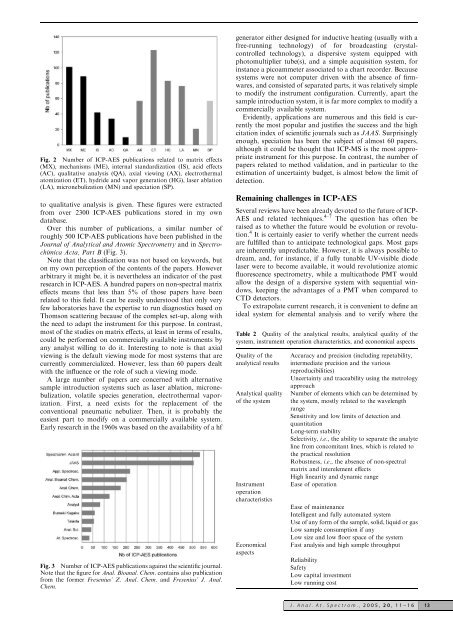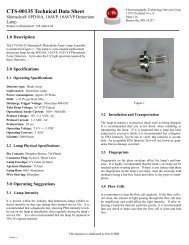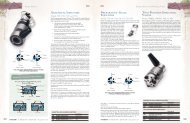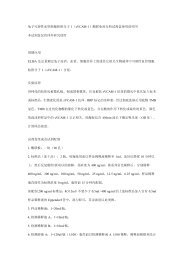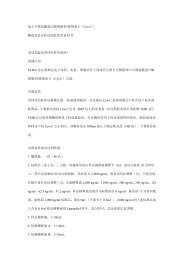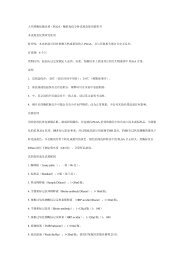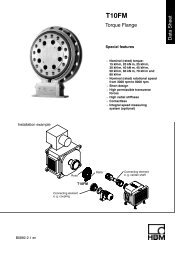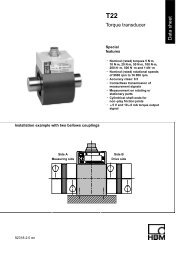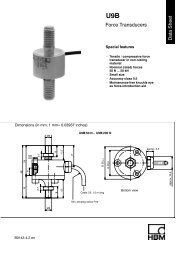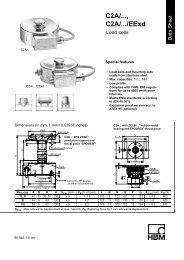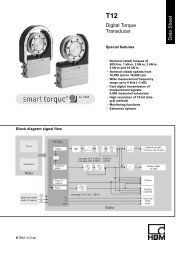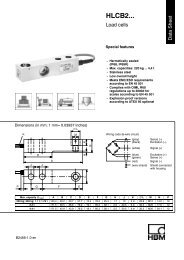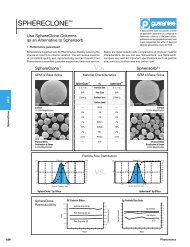Is it still possible, necessary and beneficial to perform research in ...
Is it still possible, necessary and beneficial to perform research in ...
Is it still possible, necessary and beneficial to perform research in ...
Create successful ePaper yourself
Turn your PDF publications into a flip-book with our unique Google optimized e-Paper software.
Fig. 2 Number of ICP-AES publications related <strong>to</strong> matrix effects<br />
(MX), mechanisms (ME), <strong>in</strong>ternal st<strong>and</strong>ardization (IS), acid effects<br />
(AC), qual<strong>it</strong>ative analysis (QA), axial view<strong>in</strong>g (AX), electrothermal<br />
a<strong>to</strong>mization (ET), hydride <strong>and</strong> vapor generation (HG), laser ablation<br />
(LA), micronebulization (MN) <strong>and</strong> speciation (SP).<br />
<strong>to</strong> qual<strong>it</strong>ative analysis is given. These figures were extracted<br />
from over 2300 ICP-AES publications s<strong>to</strong>red <strong>in</strong> my own<br />
database.<br />
Over this number of publications, a similar number of<br />
roughly 500 ICP-AES publications have been published <strong>in</strong> the<br />
Journal of Analytical <strong>and</strong> A<strong>to</strong>mic Spectrometry <strong>and</strong> <strong>in</strong> Spectrochimica<br />
Acta, Part B (Fig. 3).<br />
Note that the classification was not based on keywords, but<br />
on my own perception of the contents of the papers. However<br />
arb<strong>it</strong>rary <strong>it</strong> might be, <strong>it</strong> is nevertheless an <strong>in</strong>dica<strong>to</strong>r of the past<br />
<strong>research</strong> <strong>in</strong> ICP-AES. A hundred papers on non-spectral matrix<br />
effects means that less than 5% of those papers have been<br />
related <strong>to</strong> this field. It can be easily unders<strong>to</strong>od that only very<br />
few labora<strong>to</strong>ries have the expertise <strong>to</strong> run diagnostics based on<br />
Thomson scatter<strong>in</strong>g because of the complex set-up, along w<strong>it</strong>h<br />
the need <strong>to</strong> adapt the <strong>in</strong>strument for this purpose. In contrast,<br />
most of the studies on matrix effects, at least <strong>in</strong> terms of results,<br />
could be <strong>perform</strong>ed on commercially available <strong>in</strong>struments by<br />
any analyst will<strong>in</strong>g <strong>to</strong> do <strong>it</strong>. Interest<strong>in</strong>g <strong>to</strong> note is that axial<br />
view<strong>in</strong>g is the default view<strong>in</strong>g mode for most systems that are<br />
currently commercialized. However, less than 60 papers dealt<br />
w<strong>it</strong>h the <strong>in</strong>fluence or the role of such a view<strong>in</strong>g mode.<br />
A large number of papers are concerned w<strong>it</strong>h alternative<br />
sample <strong>in</strong>troduction systems such as laser ablation, micronebulization,<br />
volatile species generation, electrothermal vaporization.<br />
First, a need exists for the replacement of the<br />
conventional pneumatic nebulizer. Then, <strong>it</strong> is probably the<br />
easiest part <strong>to</strong> modify on a commercially available system.<br />
Early <strong>research</strong> <strong>in</strong> the 1960s was based on the availabil<strong>it</strong>y of a hf<br />
Fig. 3 Number of ICP-AES publications aga<strong>in</strong>st the scientific journal.<br />
Note that the figure for Anal. Bioanal. Chem. conta<strong>in</strong>s also publication<br />
from the former Fresenius’ Z. Anal. Chem. <strong>and</strong> Fresenius’ J. Anal.<br />
Chem.<br />
genera<strong>to</strong>r e<strong>it</strong>her designed for <strong>in</strong>ductive heat<strong>in</strong>g (usually w<strong>it</strong>h a<br />
free-runn<strong>in</strong>g technology) of for broadcast<strong>in</strong>g (crystalcontrolled<br />
technology), a dispersive system equipped w<strong>it</strong>h<br />
pho<strong>to</strong>multiplier tube(s), <strong>and</strong> a simple acquis<strong>it</strong>ion system, for<br />
<strong>in</strong>stance a picoammeter associated <strong>to</strong> a chart recorder. Because<br />
systems were not computer driven w<strong>it</strong>h the absence of firmwares,<br />
<strong>and</strong> consisted of separated parts, <strong>it</strong> was relatively simple<br />
<strong>to</strong> modify the <strong>in</strong>strument configuration. Currently, apart the<br />
sample <strong>in</strong>troduction system, <strong>it</strong> is far more complex <strong>to</strong> modify a<br />
commercially available system.<br />
Evidently, applications are numerous <strong>and</strong> this field is currently<br />
the most popular <strong>and</strong> justifies the success <strong>and</strong> the high<br />
c<strong>it</strong>ation <strong>in</strong>dex of scientific journals such as JAAS. Surpris<strong>in</strong>gly<br />
enough, speciation has been the subject of almost 60 papers,<br />
although <strong>it</strong> could be thought that ICP-MS is the most appropriate<br />
<strong>in</strong>strument for this purpose. In contrast, the number of<br />
papers related <strong>to</strong> method validation, <strong>and</strong> <strong>in</strong> particular <strong>to</strong> the<br />
estimation of uncerta<strong>in</strong>ty budget, is almost below the lim<strong>it</strong> of<br />
detection.<br />
Rema<strong>in</strong><strong>in</strong>g challenges <strong>in</strong> ICP-AES<br />
Several reviews have been already devoted <strong>to</strong> the future of ICP-<br />
AES <strong>and</strong> related techniques. 4–7 The question has often be<br />
raised as <strong>to</strong> whether the future would be evolution or revolution.<br />
4 It is certa<strong>in</strong>ly easier <strong>to</strong> verify whether the current needs<br />
are fulfilled than <strong>to</strong> anticipate technological gaps. Most gaps<br />
are <strong>in</strong>herently unpredictable. However, <strong>it</strong> is always <strong>possible</strong> <strong>to</strong><br />
dream, <strong>and</strong>, for <strong>in</strong>stance, if a fully tunable UV-visible diode<br />
laser were <strong>to</strong> become available, <strong>it</strong> would revolutionize a<strong>to</strong>mic<br />
fluorescence spectrometry, while a multicathode PMT would<br />
allow the design of a dispersive system w<strong>it</strong>h sequential w<strong>in</strong>dows,<br />
keep<strong>in</strong>g the advantages of a PMT when compared <strong>to</strong><br />
CTD detec<strong>to</strong>rs.<br />
To extrapolate current <strong>research</strong>, <strong>it</strong> is convenient <strong>to</strong> def<strong>in</strong>e an<br />
ideal system for elemental analysis <strong>and</strong> <strong>to</strong> verify where the<br />
Table 2 Qual<strong>it</strong>y of the analytical results, analytical qual<strong>it</strong>y of the<br />
system, <strong>in</strong>strument operation characteristics, <strong>and</strong> economical aspects<br />
Qual<strong>it</strong>y of the<br />
analytical results<br />
Analytical qual<strong>it</strong>y<br />
of the system<br />
Instrument<br />
operation<br />
characteristics<br />
Economical<br />
aspects<br />
Accuracy <strong>and</strong> precision (<strong>in</strong>clud<strong>in</strong>g repetabil<strong>it</strong>y,<br />
<strong>in</strong>termediate precision <strong>and</strong> the various<br />
reproducibil<strong>it</strong>ies)<br />
Uncerta<strong>in</strong>ty <strong>and</strong> traceabil<strong>it</strong>y us<strong>in</strong>g the metrology<br />
approach<br />
Number of elements which can be determ<strong>in</strong>ed by<br />
the system, mostly related <strong>to</strong> the wavelength<br />
range<br />
Sens<strong>it</strong>iv<strong>it</strong>y <strong>and</strong> low lim<strong>it</strong>s of detection <strong>and</strong><br />
quant<strong>it</strong>ation<br />
Long-term stabil<strong>it</strong>y<br />
Selectiv<strong>it</strong>y, i.e., the abil<strong>it</strong>y <strong>to</strong> separate the analyte<br />
l<strong>in</strong>e from concom<strong>it</strong>ant l<strong>in</strong>es, which is related <strong>to</strong><br />
the practical resolution<br />
Robustness, i.e., the absence of non-spectral<br />
matrix <strong>and</strong> <strong>in</strong>terelement effects<br />
High l<strong>in</strong>ear<strong>it</strong>y <strong>and</strong> dynamic range<br />
Ease of operation<br />
Ease of ma<strong>in</strong>tenance<br />
Intelligent <strong>and</strong> fully au<strong>to</strong>mated system<br />
Use of any form of the sample, solid, liquid or gas<br />
Low sample consumption if any<br />
Low size <strong>and</strong> low floor space of the system<br />
Fast analysis <strong>and</strong> high sample throughput<br />
Reliabil<strong>it</strong>y<br />
Safety<br />
Low cap<strong>it</strong>al <strong>in</strong>vestment<br />
Low runn<strong>in</strong>g cost<br />
J. Anal. At. Spectrom., 2005, 20, 11–16 13


